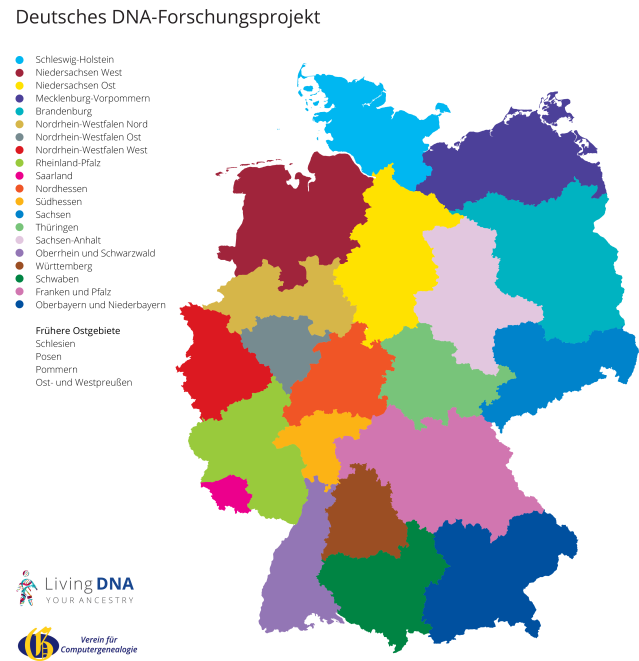Yesterday I made my annual day-trip to WhoDoYouThinkYouAre?-Live (hereafter WDYTYA?Live – please don’t make me write it out long-form again). This is the United Kingdom’s premier genealogy show. Originally held in London, it’s now moved to warehouse that is the Birmingham National Exhibition Centre.
As ever there was good coverage by the many local family-history societies within the UK, however the big exhibitors this year were the main commercial genealogical companies. DNA testing was a big feature of these companies with ancestry.com, FamilyTreeDNA, MyHeritage and LivingDNA all highlighting their products. LivingDNA were making a particular push this year, not unreasonable given that they are new and have a product that, at the moment, is particularly geared for the UK market, with it’s Family Ancestry breaking down British DNA into 21 regions. I’ve tested with LivingDNA and you can see my results here.
There was clear interest in their product and their talk “High Definition Ancestry DNA Testing in the UK” was sold-out before the show began. Fortunately I managed to blag a spare ticket last minute and thought it was worth putting down some notes on the talk. The talk was in three parts and featured LivingDNA MD David Nicholson, head of BioInformatics Dr Martin Blythe, and, er, Alex – an anthropologist at LivingDNA. Much of the information in the presentation has already been published, so I will just focus on the information that was new to myself.
- LivingDNA have previously explained that their aim was to help combat racism and help people understand how similar we all are. David Nicholson explained how the company is working with schools to push this educational aspect, through a 3 part educational program. In addition they is now working with Syrian refugees, helping the re-connect with family members and prove family relationships for asylum seekers. Well done.
- The presentation mentioned some of over 100 academic partners the company work with. WDYTYA?Live regulars Prof. Mark Jobling from Leicester and Garrett Hellenthal from UCL were among this list.
- LivingDNA already have the “Irish DNA Research Project” underway. If I got my numbers correct, they have now gathered 1200 Irish samples.
- The company has teamed up with the German Compgen (Verein für Computergenealogie e.V. – Club for Computer Genealogy) to launch Deutsches DNA-Forschungsprojekt (the German DNA Research Project), which aims to identify German regional genetic signatures (including old Eastern German provinces of Schlesien, Posen, Pommern, Ost- und Westpreußen). This project has estimated that there are 24 regions that German DNA could break down into (see map below). Speaking outside the lecture David Nicholson commented that they expect to have results by the end of the year, although a paper on the subject would be 2 or 3 years out.
- The company hopes to work on regional breakdowns in Belgium, France, the Netherlands, Portugal and Austria (if my notes are correct !).
- Outside of the presentation I was able to ask Garrett Hellenthal how LivingDNA was able to break down the genetically-similar Central and Eastern England samples from the People of the British Isles project into the LivingDNA regions (basically North Yorkshire, Lincolnshire, Central England, East Anglia, South England, Southeast England and South Central England). Garrett explained that the genetic differences were there in the original POBI data, which was re-worked for the LivingDNA results.
- Finally I checked with LivingDNA when raw-data downloads would be available. The expected time-frame is in a couple of months. The firm wants to validate all the data from the new Illumina GSA platform they use before releasing it.
A number of companies were offering discounts on DNA tests for kits sold at the show. The following offers were available:
- FamilyTreeDNA – Family Finder: £40
- AncestryDNA: £49
- LivingDNA (autosomal + mtDNA + yDNA) £99
Outside of the world of DNA, Family Tree Maker owners mackiev were there. I gather FTM 2017 is not yet ready to ship (the new TreeSync feature does not play nicely with the ancestry.com servers). When it’s ready it will be a paid for upgrade (£39), although a show alternative would be to purchase FTM2014.1 (£29) and get the free upgrade.
FindMyPast were also boasting a large stand. If you are at the show you can pick up a flyer which gives you a month’s access for £1.
[Update May 2017] Sadly this looks like itwill be the last WDYTYALive! Show. On 3rd May 2017 the organisers, Immediate Media, announced the decision to stop the show.


Thank you for sharing!
Personally, I’m dying waiting for the LivingDNA transferral. Honestly cannot wait!
I’m looking forward to reading about your results when then arrive.
That’s nice & all.
“Garrett explained that the genetic differences were there in the original POBI data, which was re-worked for the LivingDNA results.”
Except having talked with a legitimate researcher for PoBI who said if they used deeper research than grandparents – great-grandparents – they’d have CONSIDERABLY fewer references as FEW would have great-grandparents matching criteria. As a Polish friend said put enough “eye candy” on something and even rubbish sells.
If I look at my ancestors, all those that would have qualified via the POBI criteria, would also have qualified using the great grandparents rule you suggest, because they came from small rural communities where people didn’t move around much [edit] but I’m sure there are cases where this wouldn’t apply. If you require all 8 grandparents info would certainly lose “valid” samples as in many cases not all 8 great-grandparents are known.
More generally, I guess projects like POBI have to make a decision on quantity vs quality of samples. [edit] Since I’m not a population statistician I’m not going to comment on that dynamic.
PS. As you are probably aware Garrett Hellenthal was one of the POBI researchers.